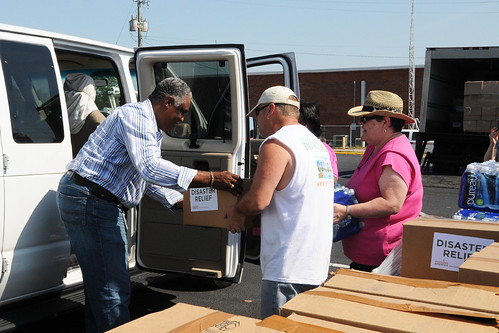A bout of flooding and tornadoes throughout parts of the Southeast have left thousands of people in need. Several USDA agencies have been working for weeks with state and local officials, as well as individuals, businesses, farmers and ranchers, as they begin the process of helping to get people back on their feet. USDA offers a variety of resources for states and individuals affected by the recent disasters. Just last week, USDA Under Secretary for Rural Development Dallas Tonsager and Acting Under Secretary for Farm and Foreign Agricultural Services Michael Scuse toured several states and met hundreds of folks affected by recent disasters.
It makes me glad that our programs are helping storm victims get back on their feet. I accompanied Donald Arnette, USDA’s Food and Nutrition Service’s (FNS) Southeast Regional Administrator, on a recent tour to assure those in need and eligible that they would receive disaster nutrition assistance at any of the following locations: disaster shelters, feeding sites, Disaster Supplemental Nutrition Assistance Program (DSNAP) sites, and food banks. The FNS disaster nutrition assistance available to eligible individuals include: DSNAP; the Special Supplemental Nutrition Assistance Program for Women, Infants and Children (WIC); and USDA Foods distributed through the Commodity Supplemental Food Programs, which also includes The Emergency Food Assistance Program (TEFAP).

TEFAP and USDA Foods are a big help to food banks and other organizations that play an integral role in disaster recovery. The Northern Alabama Food Bank alone has already distributed just over 58,000 pounds of their existing USDA Foods to disaster congregate feeding sites across the northern part of the state.
The food bank director at one location in West Alabama became visibly emotional when talking to Arnette about all that USDA Foods do for the food banks. In Fort Oglethorpe, Ga., a cafeteria manager explained that her school, which had been set up as a Red Cross shelter and congregate feeding site for the surrounding area, had used USDA Foods from their existing USDA Food Schools/Child Nutrition Program to feed disaster victims a hot meal.
We also saw Salvation Army volunteers delivering meals prepared with USDA Foods provided by the food bank, one-by-one, to homes in one of the hard hit areas of Northern Alabama. And in Birmingham, Cullman, and Tuscaloosa, we saw firsthand how staff from the Alabama Department of Human Resources and Alabama Department of Public Health worked tirelessly to serve their clients.
The trip will help the Southeast Regional Food and Nutrition Service plan for future disaster assistance and outreach, particularly in ensuring timely service to those in need of USDA nutrition assistance. As our hearts go out to everyone affected by the recent disasters, it was heartening to see how USDA programs are helping people. To witness the countless volunteers, partners, and agencies working in concert to assist those in need really brought home the importance and variety of USDA’s work in small communities throughout the country.
In the weeks and months ahead, USDA staff in the affected states will continue to work with citizens and state, local and other federal officials to provide assistance. For additional information and updates about USDA's relief efforts, please visit www.usda.gov.
To see the most recent statistics and response on disaster assistance provided by the Food and Nutrition Service click here.

